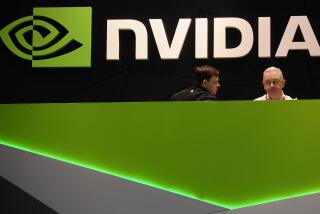Intel to buy Infineon wireless unit for $1.4 billion
Reporting from San Jose — In its second major deal in just over a week, Intel Corp. has agreed to buy Germany-based Infineon Technologies’ wireless communications unit for $1.4 billion in cash.
Santa Clara-based Intel, the world’s largest chip maker, hopes the move will help it gain a foothold in the fast-growing market for smart phones and other mobile gadgets.
The Infineon unit makes chips for smart phones including Apple Inc.’s iPhone. Intel, which has had trouble getting its chips into products other than personal computers, also agreed Aug. 19 to buy McAfee Inc., the Santa Clara maker of security software, for $7.7 billion — the biggest deal in Intel’s history.
“We are committed to positioning Intel to take advantage of that growth potential in every computing segment, from laptops to handhelds and beyond,” Intel Chief Executive Paul Otellini said when announcing the Infineon deal Sunday night.
Infineon says the deal will allow it to focus on its core automotive, industrial and chip card and security divisions.
Although Intel’s x86 chips are used as the brains in 80% of personal computers, the vast majority of smart phones rely on chips based on a design licensed from a British company, ARM Holdings. That’s largely because Intel’s chips are less energy-efficient and more likely to shorten the battery life of smart phones than those using the ARM design.
Consequently, Intel recently has developed a microprocessor dubbed Atom, which uses less power than its other chips. But experts say it may take several years before Intel reduces Atom’s power consumption enough for it to be a serious competitor to the ARM chips.
“You can’t walk into the phone market today and just offer somebody a processor,” said Linley Gwennap, a chip analyst with the Linley Group. “You need to offer them a complete smart-phone design.”
That seems to be Intel’s plan. By buying McAfee, the firm hopes to make its chips more attractive for smart phones by bolstering them with McAfee’s security software. The Infineon purchase would give Intel another key technology.
Smart phones rely on two main chips: an application processor, which oversees the phone’s basic functions, and a baseband processor, which lets the phone communicate with other gadgets. Because Intel’s Atom is an application processor and Infineon makes a baseband processor, Intel would own both components that smart-phone makers need.
Moreover, by owning Infineon’s technology — instead of just licensing it — Intel could more easily manipulate it to work more effectively with its Atom processor, experts said.
“Intel is always looking ahead,” said Nathan Brookwood, a research fellow at Saratoga market consulting firm Insight 64.
As several ARM chipmakers have already done, he said, Intel would probably merge both processors onto a single chip because the move would “save space, it would reduce cost and it would improve battery life.”
Intel’s Atom will eventually be able to challenge ARM’s smart-phone dominance, said Jim McGregor, chief technology strategist at technology market intelligence firm In-Stat. But “it’s definitely a challenge for Intel to break out of its core competency and its traditional market,” he said.
The company had spent billions of dollars on communications and other businesses around the time of the dot-com boom, only to shed them later. Those forays included some ARM-based cellphone chip technologies dubbed XScale, which Intel sold to Marvell Technology Group in 2006 and which Marvell has turned into a big moneymaker.
As a result, some analysts are less than enthusiastic about Intel jumping back into the ARM communication-chip arena, a sentiment mirrored in a recent note to investors from Craig Berger of FBR Capital Markets.
“We feel we have seen this movie before,” he said.
Steve Johnson writes for the San Jose Mercury News/McClatchy.




